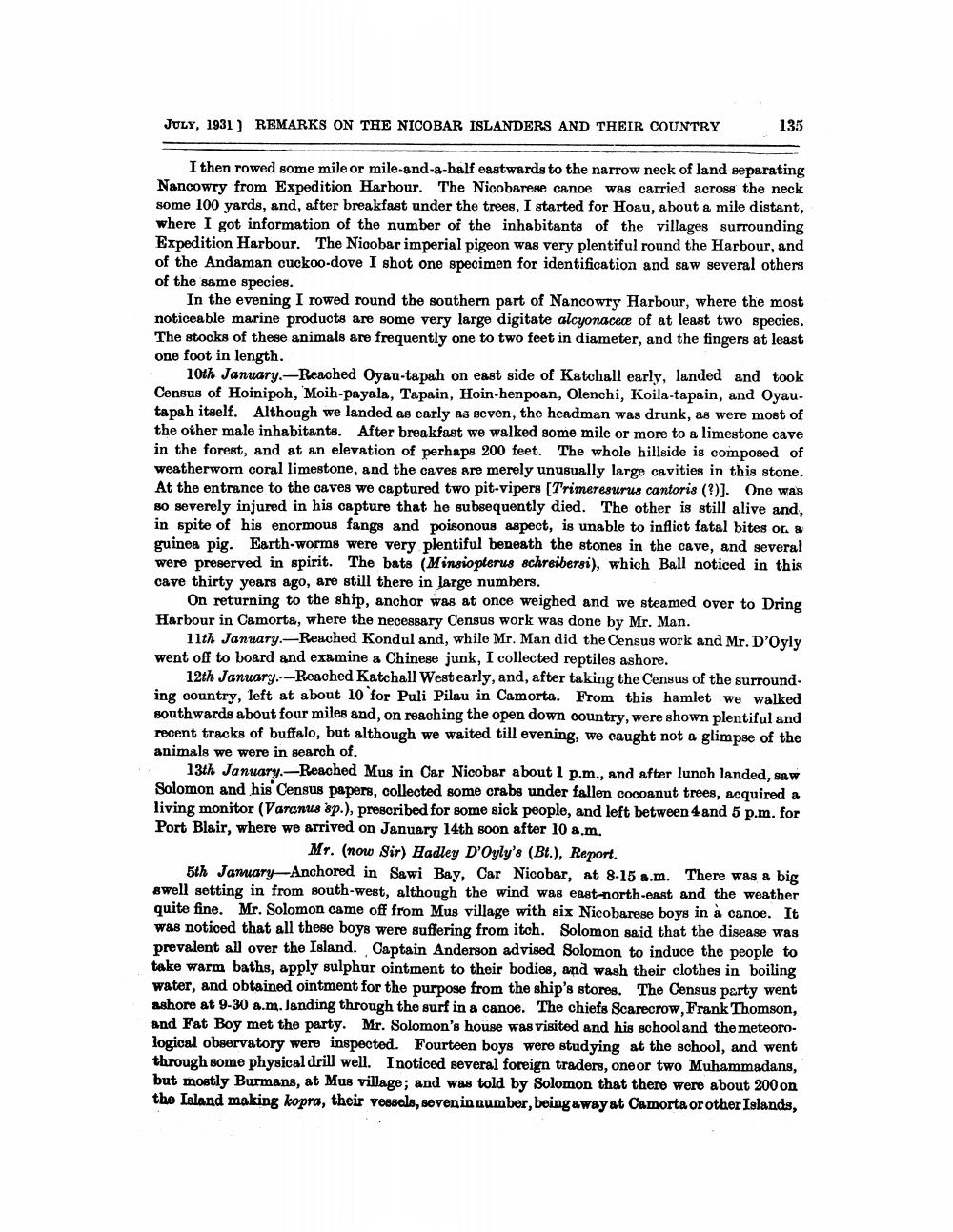________________
JULY, 1931) REMARKS ON THE NICOBAR ISLANDERS AND THEIR COUNTRY
135
I then rowed some mile or mile-and-a-half eastwards to the narrow neck of land separating Nancowry from Expedition Harbour. The Nicobarese canoe was carried across the neck some 100 yards, and, after breakfast under the trees, I started for Hoau, about a mile distant, where I got information of the number of the inhabitants of the villages surrounding Expedition Harbour. The Nicobar imperial pigeon was very plentiful round the Harbour, and of the Andaman cuckoo-dove I shot one specimen for identification and saw several others of the same species.
In the evening I rowed round the southern part of Nancowry Harbour, where the most noticeable marine products are some very large digitate alcyonacece of at least two species. The stocks of these animals are frequently one to two feet in diameter, and the fingers at least one foot in length.
10th January --Reached Oyau-tapah on east side of Katchall early, landed and took Census of Hoinipoh, Moih-payala, Tapain, Hoin-henpoan, Olenchi, Koila-tapain, and Oyautapah itself. Although we landed as early as seven, the headman was drunk, as were most of the other male inhabitants. After breakfast we walked some mile or more to a limestone cave in the forest, and at an elevation of perhaps 200 feet. The whole hillside is composed of weatherworn coral limestone, and the caves are merely unusually large cavities in this stone. At the entrance to the caves we captured two pit-vipers [Trimeresurus cantoris (?)]. One was 80 severely injured in his capture that he subsequently died. The other is still alive and, in spite of his enormous fangs and poisonous aspect, is unable to inflict fatal bites or guinea pig. Earth-worms were very plentiful beneath the stones in the cave, and several were preserved in spirit. The bats (Minsiopterus schreibersi), which Ball noticed in this cave thirty years ago, are still there in large numbers.
On returning to the ship, anchor was at once weighed and we steamed over to Dring Harbour in Camorta, where the necessary Census work was done by Mr. Man.
11th January.-Reached Kondul and, while Mr. Man did the Census work and Mr. D'Oyly went off to board and examine a Chinese junk, I collected reptiles ashore.
12th January --Reached Katchall West early, and, after taking the Census of the surrounding country, left at about 10 for Puli Pilau in Camorta. From this hamlet we walked southwards about four miles and, on reaching the open down country, were shown plentiful and recent tracks of buffalo, but although we waited till evening, we caught not a glimpse of the animals we were in search of.
13th January.Reached Mus in Car Nicobar about 1 p.m., and after lunch landed, saw Solomon and his Census papers, collected some crabs under fallen cocoanut trees, acquired a living monitor (Varonus sp.), prescribed for some sick people, and left between 4 and 5 p.m. for Port Blair, where we arrived on January 14th soon after 10 a.m.
Mr. (now Sir) Hadley D'Oyly's (Bt.), Report. 5th January-Anchored in Sawi Bay, Car Nicobar, at 8.15 a.m. There was a big swell setting in from south-west, although the wind was east-north-east and the weather quite fine. Mr. Solomon came off from Mus village with six Nicobarese boys in à canoe. It was noticed that all these boys were suffering from itch. Solomon said that the disease was prevalent all over the Island. Captain Anderson advised Solomon to induce the people to take warm baths, apply sulphur ointment to their bodies, and wash their clothes in boiling water, and obtained ointment for the purpose from the ship's stores. The Census party went ashore at 9-30 a.m. Janding through the surf in & canoe. The chiefs Scarecrow, Frank Thomson, and Fat Boy met the party. Mr. Solomon's house was visited and his school and the meteorological observatory were inspected. Fourteen boys were studying at the school, and went through some physical drill well. I noticed several foreign traders, one or two Muhammadans, but mostly Burmans, at Mus village, and was told by Solomon that there were about 200 on the Island making kopra, their vessels, seven in number, being away at Camorta or other Islands,




